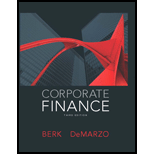
Concept explainers
a)
To determine: The highest expected payoff in the given projects.
Introduction:
Expected payoff is also known as expected value, which uses the probabilities to compute the definite outcome.
b)
To determine: The highest expected payoff for the equity holder.
Introduction:
Expected payoff is also known as expected value, which uses the probabilities to compute the definite outcome.
c)
To determine: The highest expected payoff for the equity holder.
Introduction:
Expected payoff is also known as expected value, which uses the probabilities to compute the definite outcome.
d)
To determine: The expected agency cost of the firm if the debts are $40 million and $110 million.
Introduction:
Expected payoff is also known as expected value, which uses the probabilities to compute the definite outcome.
Want to see the full answer?
Check out a sample textbook solution
Chapter 16 Solutions
Corporate Finance
- Which of the following statements is true about a bond's yield to maturity (YTM)?A) YTM is the interest rate that makes the present value of bond payments equal to its current market priceB) YTM is only calculated at the time of purchaseC) YTM does not account for the bond’s coupon paymentsD) YTM is the same as the bond’s coupon rate if purchased at face valuearrow_forwardWhich of the following would likely decrease the cost of debt for a company?A) An increase in the company's credit ratingB) A decrease in the company's profitabilityC) A rise in interest rates across the marketD) An increase in the company's dividend payoutsarrow_forwardWhich of the following is considered a long-term financing source for a company?A) Accounts PayableB) Common StockC) Short-term loansD) Accrued Expenses helparrow_forward
- Which of the following is considered a long-term financing source for a company?A) Accounts PayableB) Common StockC) Short-term loansD) Accrued Expensesarrow_forwardWhat is the primary goal of financial management?A) Maximizing profitsB) Maximizing shareholder wealthC) Minimizing costsD) Ensuring liquidityhelp.arrow_forwardIf a bond has a coupon rate lower than the market interest rate, the bond will sell at:A) Par valueB) A premiumC) A discountD) Its face valuehelp.arrow_forward
- If a bond has a coupon rate lower than the market interest rate, the bond will sell at:A) Par valueB) A premiumC) A discountD) Its face valuearrow_forwardThe primary objective of financial accounting is to:a) Provide management with detailed reports for decision-making.b) Help the company save taxes.c) Provide financial information to external users.d) Track inventory levels. please help.arrow_forwardWhich of the following is an example of a capital budgeting decision?A) Determining the amount of inventory to keep on handB) Deciding whether to purchase a new piece of machineryC) Setting the credit terms for customersD) Deciding how much cash to keep in the bankarrow_forward
- For pueblo super market in st thomas usviarrow_forwardWhat is the methodology that capital markets serve as engines of economic growth and innovation? Could you help explain how methodology is critical to successful of the capital market? How are they also vulnerable to significant structural and behavioral problems? What are the appropriate uses of a qualitative single case study, and what types of research are best suited for the study of capital markets? What is the research framework of the capital market?arrow_forwardWhat is the purpose of the Capital Markets? What are the qualitative research questions that Capital Markets seek to understand or explain, while quantitative research questions seek to relate or measure? What could be the problems of Capital Markets, and how can the problems of Capital Markets be solved? How can the practice or issue be improved?arrow_forward
 EBK CONTEMPORARY FINANCIAL MANAGEMENTFinanceISBN:9781337514835Author:MOYERPublisher:CENGAGE LEARNING - CONSIGNMENT
EBK CONTEMPORARY FINANCIAL MANAGEMENTFinanceISBN:9781337514835Author:MOYERPublisher:CENGAGE LEARNING - CONSIGNMENT
